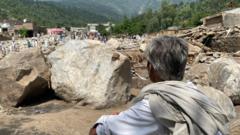Nestled among the lush green mountains of Pakistan's north, the village of Bishnoi was once renowned for its scenic beauty, with a gentle river flowing through its heart. However, on the morning of August 15, a sudden torrent of rain transformed that tranquility into calamity. Villagers, starting their day unaware of the impending threat, were caught off guard as raging floodwaters surged into their homes, accompanied by rocks and debris that crushed everything in their path.
According to locals, the severity of the flood was devastating, with large stones scattered across the area, marking what was once vibrant living spaces now reduced to rubble. Rescue efforts are being undertaken by both community members and local authorities who are trying to sift through the debris to locate friends and family buried beneath the ruins. "There is a house under every stone. People try to look under these rocks to see if they can find someone," remarked Israr Khan, a local resident witnessing the ongoing tragedy.
The toll has been staggering across the province of Khyber Pakhtunkhwa, where official reports indicate that at least 314 individuals have lost their lives, with hundreds more injured due to the relentless rains and flash floods that began late last week. Buner district, where Bishnoi is situated, has been reported as the worst-hit area, with 217 fatalities recorded.
Many families have been devastated by the suddenness of the disaster, particularly those in Bishnoi, where around 80 to 90 homes were predominantly agricultural. Approximately half of these houses have been completely devastated, and the rest are rendered unlivable. Eyewitness accounts detail tragic incidents, including a family destroyed during wedding preparations, underscoring the indiscriminate nature of the floods.
This year's monsoon season, which typically wreaks havoc from June through September, has already claimed over 650 lives across South Asia. In Pakistan alone, the National Disaster Management Agency reports that fatalities from monsoon-related incidents have exceeded 507 this season, with vulnerable regions experiencing the worst of it, especially Khyber Pakhtunkhwa.
Global warming has been linked to accelerated glacier melt, leading to increased flooding and landslides in these vulnerable mountainous areas. Government meteorologists have warned that heavy rainfall is likely to continue through August 21, prompting multiple regions to be declared disaster zones.
Amidst the chaos, stories of bravery have emerged, like that of a school principal in the nearby Swat Valley who evacuated nearly 900 students moments before floodwaters inundated their school. Sadly, not all were as fortunate. Abdul Salam, a resident of Punjab, recounted frantically trying to contact his family during the floods, only to learn that his wife and children had drowned.
The search for missing individuals continues, with citizens, relief organizations, and military personnel collaborating in ongoing recovery efforts. In the market areas, locals are beginning the arduous process of cleanup, despite great loss, as hope for rebuilding flickers amidst the devastation. Reports indicate surviving family members struggling emotionally to comprehend the scale of the disaster, caught in the overwhelming grief of suddenly lost loved ones.
As communities begin to piece together their lives, the spirit of solidarity remains strong, with volunteers traveling from afar to assist those affected. However, the road to recovery will be long and fraught with challenges, as the community mourns its losses while navigating the practical realities of restoration and rebuilding.



















